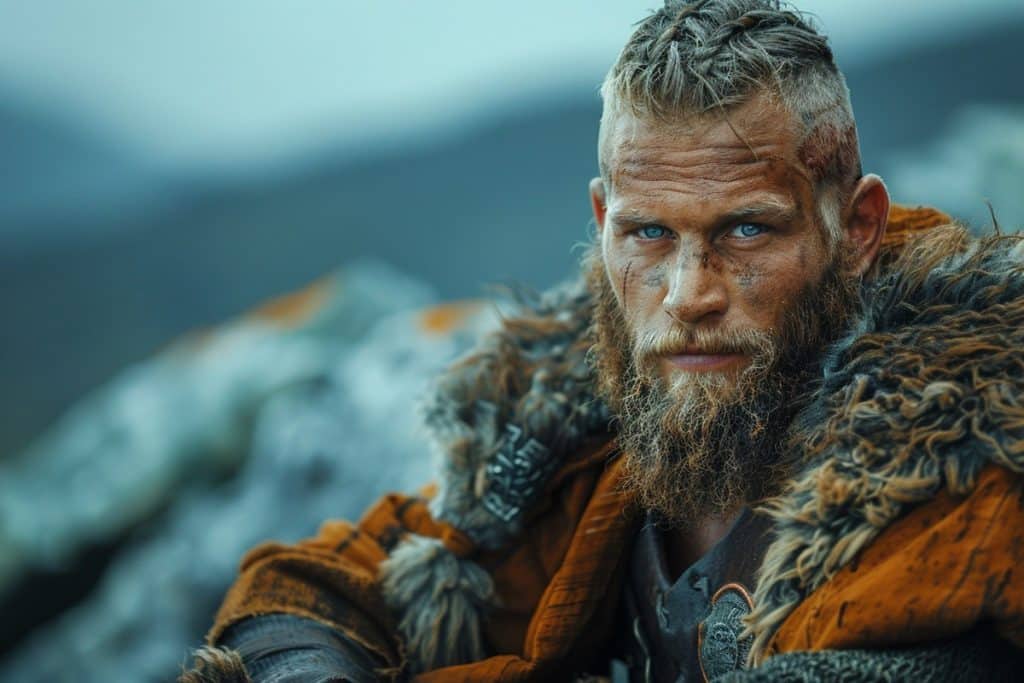1) Reaching North America (c. AD 1000)
Centuries before Columbus, Norse sailors from Greenland and Iceland crossed the North Atlantic and made landfall in North America. The best-known site is L’Anse aux Meadows in Newfoundland, a short-lived base dating to around AD 1000. This was no fluke: it capped decades of westward exploration, using sturdy cargo ships (knarr) and the same seamanship that had already carried them safely to Iceland and Greenland.
While Norse settlement in “Vinland” didn’t stick, the crossing itself shows how confident and capable Viking navigation had become—oceanic in scale, and logistical enough to move people, timber, and livestock across sub-Arctic seas. You can experience that same spirit of exploration when playing the Escape The North online slots game, where multiplier wilds and bonus spins, among other features, are included in the game.

Image courtesy of Freepik
2) Conquest, Rule, and Lasting Settlement in the British Isles
From the late 8th century, Vikings shifted from hit-and-run raiding to campaigns of conquest and settlement. In England, the Great Heathen Army (arriving in 865) overran large swathes of the country. By the late 9th century, the Danelaw—a zone of Scandinavian law and custom—was recognised in the east and north. Norse leaders minted coins in York (Jórvík), reshaped urban life, and left a deep linguistic legacy (think of place-names ending in -by, -thorpe, and -thwaite). In the 11th century, Cnut (Canute) forged a North Sea empire linking England, Denmark, and Norway (1016–1035), integrating administration and trade across the region.
Beyond England, Norse power defined the Kingdom of the Isles—Man, the Hebrides, and parts of the Irish Sea world—while the Earldoms of Orkney and Shetland anchored Scandinavian influence in the far north. Dublin, founded as a longphort (ship-camp) in the 9th century, became a major slave-trading and commercial hub. This wasn’t just raiding; it was durable state-building that left marks on language, law, town plans, and coinage.
In addition to the expedition to North America, Viking themed online casino slots also draw inspiration from their conquests across Europe. A title such as Viking Runecraft springs to mind when considering the Vikings’ occupation of England and Ireland as well as parts of France, Germany, Portugal, and Spain. Many of the typical Viking themes are reflected in the game’s symbols, featuring axes, pendants, and hammers that appeal to fans of this title. History is brought to life in a contemporary form of popular entertainment.
3) Shaping the Origins of the Rus’ and Opening the “Water Roads”
In the east, Scandinavian traders and war-leaders—often called Varangians—moved along the river systems from the Baltic down to the Black Sea and Caspian. They established fortified bases, levied tribute, and integrated with Slavic and Finnic communities. The ruling Rurikid dynasty, traditionally linked to Norse origins, presided over the rise of polities like Novgorod and Kyiv. Whatever the precise balance between Norse and Slavic elements (still debated), the achievement is clear: the Vikings tied northern Europe to Byzantium and the Islamic world via the “route from the Varangians to the Greeks.”
Treaties with Constantinople and service in the famed Varangian Guard cemented this connection, funnelling silver, silk, and ideas back up to the Baltic and Scandinavia. These legendary voyages have also inspired online slot titles such as Vikings: Fight For Honour, which draws on Norse mythology featuring Odin and Thor venturing into the unknown. The game’s symbols include male and female Vikings, paws, and eagles—elements that reflect the enduring imagery of Viking legend.
4) Mastery of Shipbuilding and Seamanship
If the Viking Age has a beating heart, it’s the ship and this iconic vessel can also be found in many Vikings themed slots titles. Viking Clash is played to an ocean backdrop with a mighty longship dominating the landscape. Vikings Go Berzerk even uses the sail of the longship as the background for the 5×4 reel formation. But going back into the history books to the Viking era, it is clear to see where game developers get their inspiration for game design from and where an original blueprint for all the modern day vessels originated.
Clinker-built hulls (overlapping planks) produced light, flexible vessels that could handle North Atlantic swells. Another benefit was that they draw so little water they could slip up rivers or be dragged over portages. Those longships moved warriors quickly; the broader-beamed knarr hauled cargo, people, and animals—enabling colonisation. Combined with rigorous practical navigation—coastal piloting, reading sun, stars, swell, birds, and the colour of water—this technology multiplied everything else the Vikings did: raiding, trading, state-building, and exploration. Without these ships, there is no Danelaw, no Dublin, no Novgorod, no Greenland farms, and certainly no Vinland.
5) Renowned Warriors: From Shieldwalls to the Varangian Guard
Vikings earned a fearsome martial reputation built on flexibility and discipline rather than myth alone. At home and abroad, they fought in shieldwalls with tight cohesion, used mobile tactics enabled by ships, and excelled at coastal raids, riverine strikes, and winter campaigning. They adapted quickly to siegecraft—building and assaulting fortifications—and were pragmatic about arms and armour, combining Scandinavian kit with locally sourced equipment.
The toughness of the Vikings is mirrored in nearly all Vikings themed online slots games (perhaps not Le Viking, which takes a more humours, animated approach to game design), echoed by the various soundtracks that accompany the reel-spinning action in each title that depict atmospheres of triumph and intensity. Their prowess made them coveted mercenaries. In Byzantium, Norsemen served as the Varangian Guard—an elite corps famed for loyalty to the emperor and shock value in battle.
Service there paid well, hardened veterans, and moved ideas and luxuries between worlds; runic graffiti in Constantinople hints at their presence. In the west, Anglo-Scandinavian huscarls formed professional household troops, anchoring royal power with disciplined infantry armed with spears, axes, and mail. The broader legacy is a transition toward more professional, well-equipped infantry in northern Europe—martial competence that underpinned Viking state-building from York to Kyiv.
